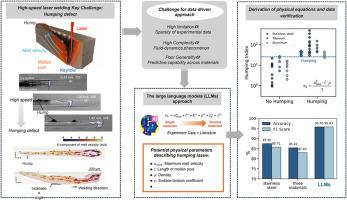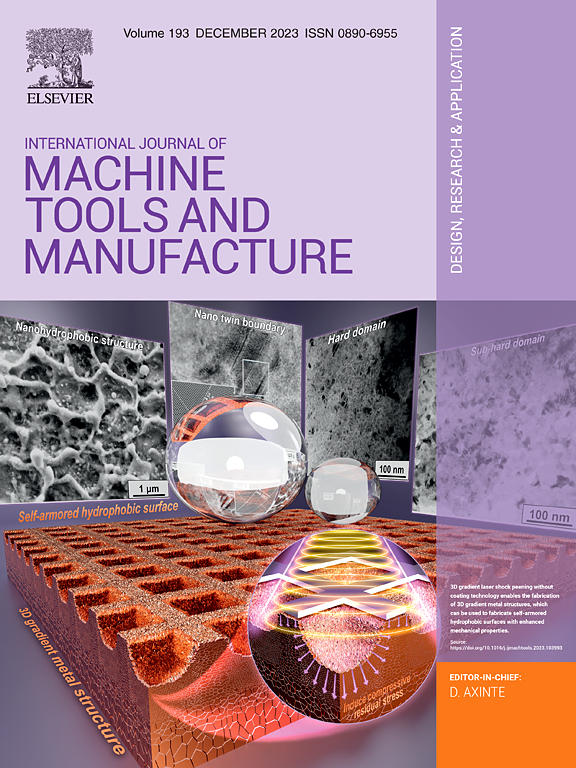Derivation of physical equations for high-speed laser welding using large language models
IF 18.8
1区 工程技术
Q1 ENGINEERING, MANUFACTURING
International Journal of Machine Tools & Manufacture
Pub Date : 2025-08-20
DOI:10.1016/j.ijmachtools.2025.104320
引用次数: 0
Abstract
It is challenging to formulate complex physical phenomena that occur in a manufacturing process, particularly when the available data are limited, rendering conventional data-driven approaches ineffective. This study aims to predict humping onset in high-speed laser welding by introducing a novel framework, namely text-to-equations generative pre-trained transformer (T2EGPT). This method leverages the capabilities of large language models (LLMs), in combination with sparse experimental data and enriched literature data, to derive an interpretable and generalizable equation for predicting humping initiation. By capturing key correlations among physical parameters, T2EGPT generates a compact and dimensionless expression that accurately predicts hump formation. The equation reveals that humping arises from the interplay between inertia-driven backward melt flow and capillary-driven surface stabilization, where inertial forces drive molten metal backward and capillary forces resist surface deformation. Compared to traditional data-driven models, T2EGPT demonstrates enhanced predictive accuracy and cross-material transferability. More broadly, this study highlights the potential of LLMs to integrate textual information with data-driven discovery, enabling the extraction of physical laws in data-scarce scientific domains.

用大语言模型推导高速激光焊接物理方程
对于制造过程中发生的复杂物理现象,特别是在可用数据有限的情况下,传统的数据驱动方法是无效的。本研究旨在通过引入一个新的框架,即文本-方程生成预训练变压器(T2EGPT)来预测高速激光焊接中的驼峰发生。该方法利用大型语言模型(llm)的能力,结合稀疏的实验数据和丰富的文献数据,推导出一个可解释和可推广的预测驼峰起始的方程。通过捕获物理参数之间的关键相关性,T2EGPT生成一个紧凑的无量纲表达式,可以准确预测驼峰的形成。由方程可知,驼峰是由惯性力驱动的熔体向后流动和毛细力驱动的表面稳定相互作用产生的,其中惯性力驱动金属液向后流动,毛细力抑制表面变形。与传统的数据驱动模型相比,T2EGPT具有更高的预测准确性和跨材料可移植性。更广泛地说,这项研究强调了法学硕士将文本信息与数据驱动的发现相结合的潜力,从而能够在数据稀缺的科学领域中提取物理定律。
本文章由计算机程序翻译,如有差异,请以英文原文为准。
求助全文
约1分钟内获得全文
求助全文
来源期刊
CiteScore
25.70
自引率
10.00%
发文量
66
审稿时长
18 days
期刊介绍:
The International Journal of Machine Tools and Manufacture is dedicated to advancing scientific comprehension of the fundamental mechanics involved in processes and machines utilized in the manufacturing of engineering components. While the primary focus is on metals, the journal also explores applications in composites, ceramics, and other structural or functional materials. The coverage includes a diverse range of topics:
- Essential mechanics of processes involving material removal, accretion, and deformation, encompassing solid, semi-solid, or particulate forms.
- Significant scientific advancements in existing or new processes and machines.
- In-depth characterization of workpiece materials (structure/surfaces) through advanced techniques (e.g., SEM, EDS, TEM, EBSD, AES, Raman spectroscopy) to unveil new phenomenological aspects governing manufacturing processes.
- Tool design, utilization, and comprehensive studies of failure mechanisms.
- Innovative concepts of machine tools, fixtures, and tool holders supported by modeling and demonstrations relevant to manufacturing processes within the journal's scope.
- Novel scientific contributions exploring interactions between the machine tool, control system, software design, and processes.
- Studies elucidating specific mechanisms governing niche processes (e.g., ultra-high precision, nano/atomic level manufacturing with either mechanical or non-mechanical "tools").
- Innovative approaches, underpinned by thorough scientific analysis, addressing emerging or breakthrough processes (e.g., bio-inspired manufacturing) and/or applications (e.g., ultra-high precision optics).

 求助内容:
求助内容: 应助结果提醒方式:
应助结果提醒方式:


